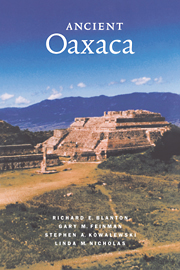Book contents
2 - The Valley of Oaxaca: a regional setting for an early state
Published online by Cambridge University Press: 05 June 2012
Summary
When we speak with the public or beginning students about the pre- Hispanic inhabitants of Mesoamerica, they generally are familiar with the Aztecs, the Maya, and even the great Classic-period central Mexican site of Teotihuacan. There is less recognition of the ancient societies of Oaxaca. This lack of familiarity is somewhat peculiar because the earliest evidence for Mesoamerican writing, dating to 600 B.C., has been found in the Valley of Oaxaca (see box 3). Likewise, Mesoamerica's earliest city, Monte Albán, scenically situated on a 400-meter-high hill at the core of one of Mesoamerica's first states, was founded at the center of the valley around 500 B.C. This early urban center was the capital of a state that endured and remained influential for more than 1000 years.
Archaeologists have long been interested in Monte Albán and its history, antecedents, and surroundings (see Whitecotton 1977). Nineteenth-century archaeological explorers described the famous hilltop city and its carved stones and monumental architectural ruins (e.g., Holmes 1895–97). These pioneers recognized that the glyphs carved on stones at Monte Albán are different from those of the ancient Maya in the eastern lowlands of Mesoamerica. They also noted certain shared conventions between these two sets of hieroglyphs, such as a numerical system in which a bar stood for five and a dot for one.
In the 1920s, the pathbreaking Mexican anthropologist Alfonso Caso first identified the Oaxacan stones as culturally Zapotec, carefully describing the differences between Zapotec writing and that found in other regions (Caso 1928, 1965a and b).
- Type
- Chapter
- Information
- Ancient Oaxaca , pp. 22 - 47Publisher: Cambridge University PressPrint publication year: 1999

